Physical Address
304 North Cardinal St.
Dorchester Center, MA 02124
Physical Address
304 North Cardinal St.
Dorchester Center, MA 02124

Discover 23 striking industrial bathroom ideas that transform ordinary spaces with exposed brick, concrete vanities, black fixtures, and authentic factory-inspired elements. Create a bathroom with urban edge and raw character.
At first glance, industrial and Scandinavian design might seem like unlikely partners. One speaks of raw, urban grit; the other of serene, natural calm. Yet, after more than a decade in Nordic interior design, I’ve found a surprising and beautiful harmony between them.
The connection is honesty. Both aesthetics champion materials for what they are—wood, metal, stone, concrete. Both value function. But where industrial design can sometimes feel cold or severe, Scandinavian principles can bring in the essential warmth and light that turn a space into a home. It’s not about recreating a factory in your house. It’s about borrowing its honesty and then infusing it with comfort. With hygge.
So, if you’re drawn to that rugged character but worry about it feeling unwelcoming, stay with me. Let’s explore how to strike that perfect balance, creating a bathroom that is both strong and serene.
An exposed brick wall isn’t just a surface; it’s a story. The slight variations in color, the texture that begs to be touched—it brings an immediate, organic warmth that paint simply can’t replicate. I once worked on a restoration in an old Copenhagen apartment where we uncovered a wall of 19th-century brick. The client was hesitant, worried it was “too much.” By the end, it was her favorite part of the home. The way the morning light would rake across it became a daily work of art.
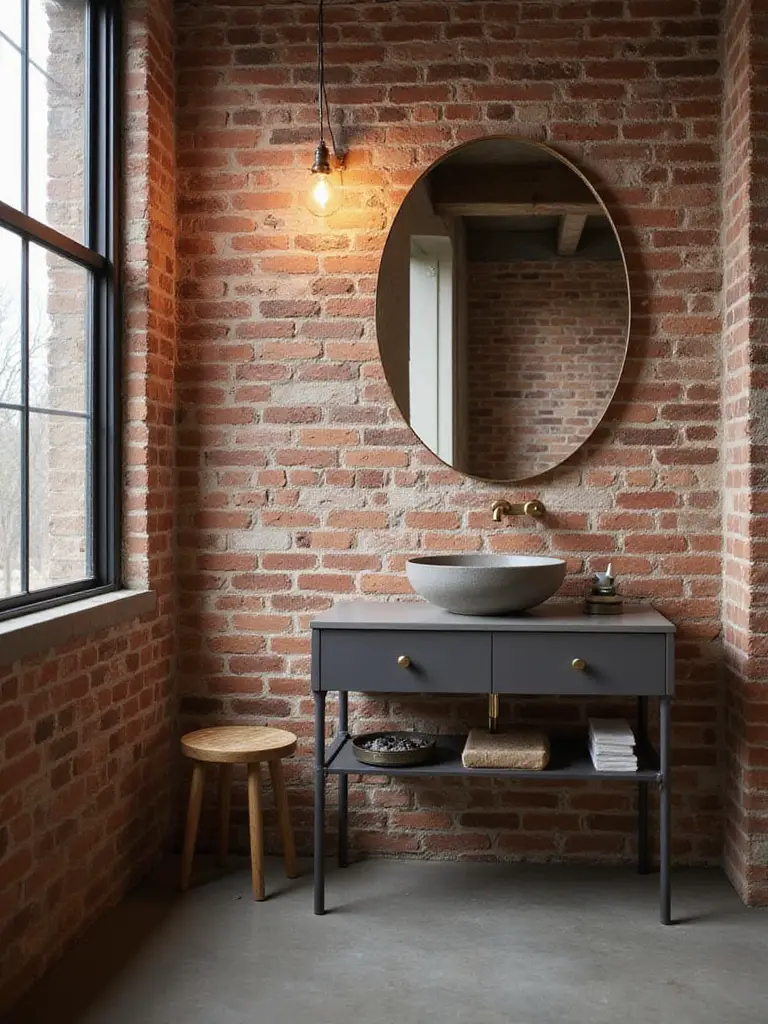
However, brick is porous. This is non-negotiable in a bathroom: you must seal it, and seal it well. Use a quality penetrating sealer and apply it meticulously. This is where I see people cut corners, and it’s a mistake that can ruin the wall over time. What I often tell my clients is to think of the brick less as a wall and more as a heavy textile. It adds a layer of texture and warmth, so let other elements in the room be simpler to allow it to breathe.
Concrete. It sounds cold, I know. And frankly, in a Nordic climate, an unheated concrete floor is a recipe for misery. But when done right, concrete is one of the most honest and grounding materials you can use. Its beauty is in its imperfections—the tiny air bubbles, the subtle shifts in tone. Each surface is unique. For a project in Stockholm, we poured a concrete vanity and embedded a radiant heating system in the floor. The result was this incredible contrast: the visual strength of raw concrete, but a floor that was a quiet, deep warmth underfoot. Pure comfort.
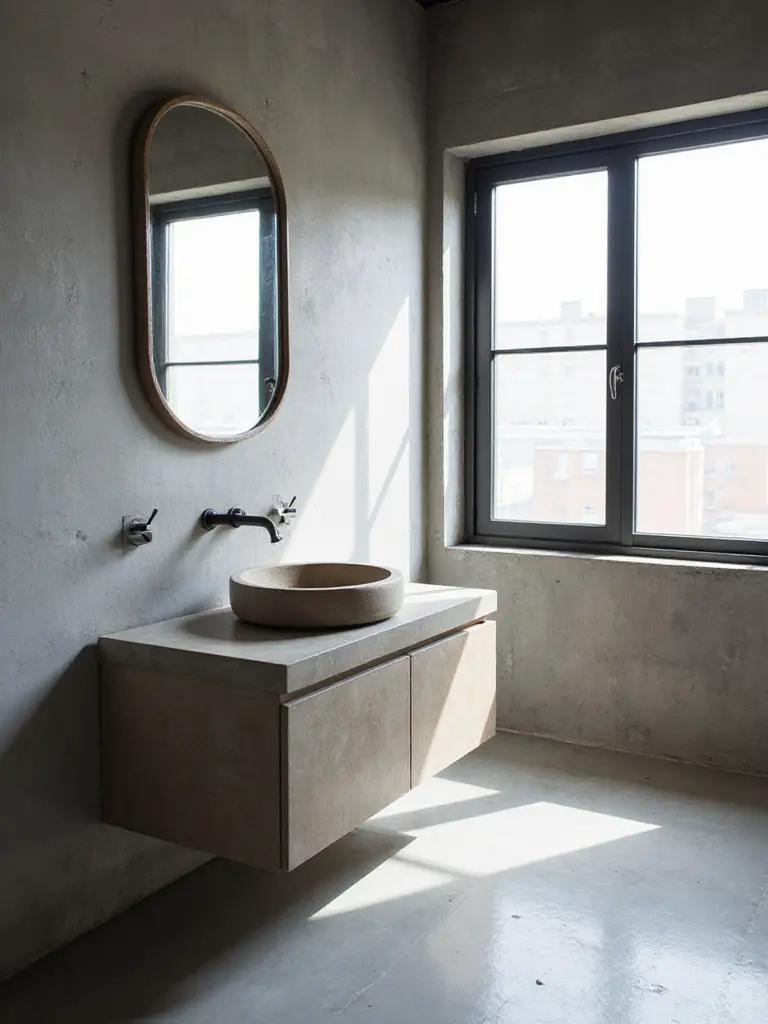
In my experience with sustainable materials, the longevity of properly sealed concrete is its quiet superpower. This isn’t a surface you’ll replace in five years. You can choose pre-cast sinks or have a countertop poured perfectly for your space. Just remember that it’s heavy, so your cabinetry or floor joists need to be up to the task. This is foundational minimalism at its best.
Here is where the principle of functional honesty truly shines. In Scandinavian furniture, you often see exposed joinery—a celebration of how the piece is held together. Exposed pipes in a bathroom serve the same purpose. They are the mechanics of the room, laid bare. Instead of hiding the function, you make it a feature. A beautiful one.
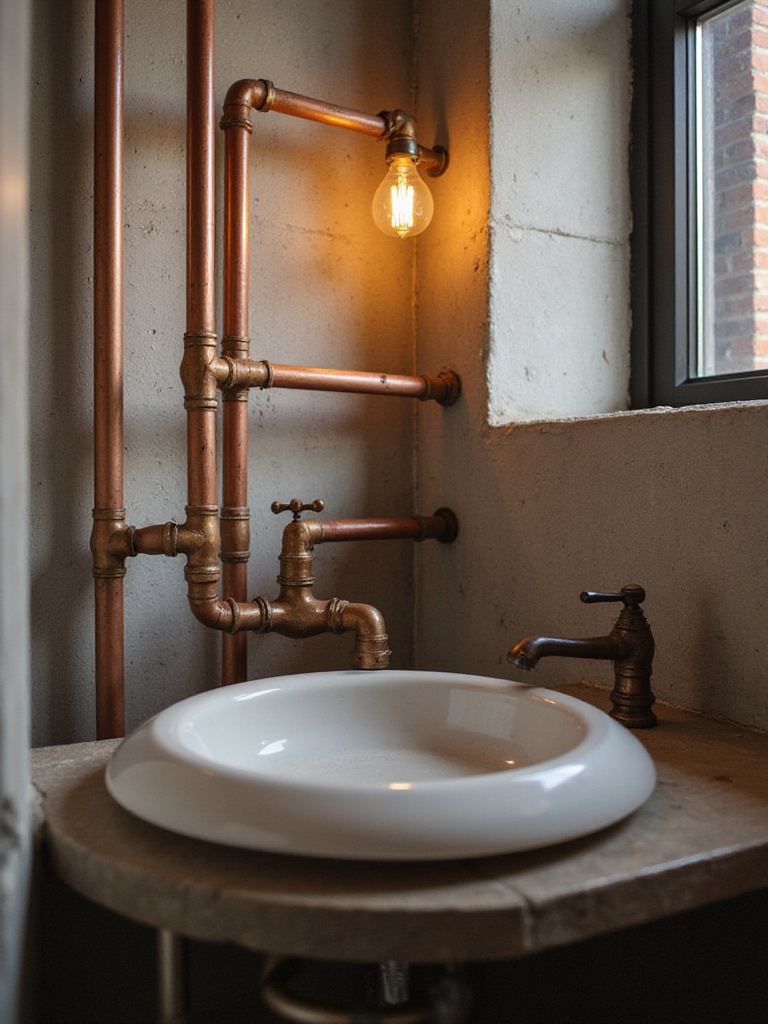
But this is where it gets tricky. Randomly exposed pipes can just look… unfinished. From my years in Nordic interior design, I’ve learned the key is intentionality. The pipes need choreography. Arrange them with a sense of order and rhythm. A client once chose to run their copper pipes for a wall-mounted faucet in a perfectly parallel, clean line up the wall. Over time, the copper has started to develop a rich, warm patina that beautifully contrasts the cool gray tile behind it. It’s a living finish, a sculpture that also happens to bring you water.
Light is everything in Scandinavian design. We spend a lot of time thinking about how to capture it, diffuse it, and create pockets of warmth with it, especially during the long winters. Industrial cage lighting, surprisingly, fits this philosophy perfectly. The cage itself is a piece of simple, functional sculpture, but the magic is in the bulb you choose.
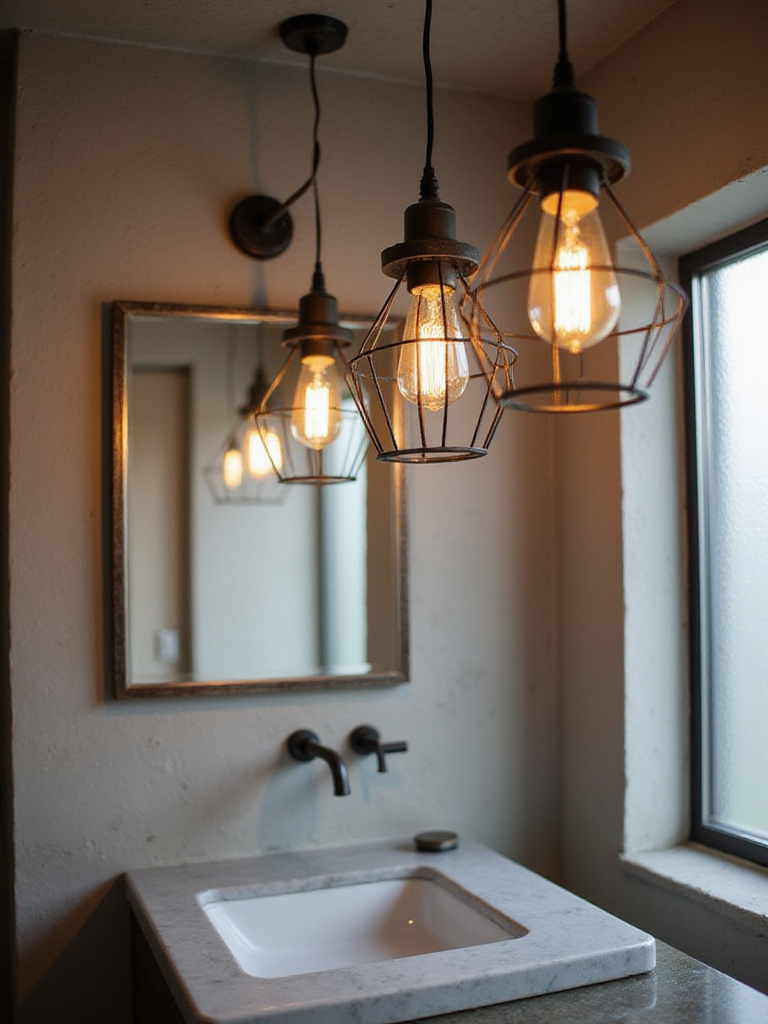
An Edison-style bulb with its warm, amber filament is an instant dose of hygge. It casts a soft glow that takes the hard edge off of materials like concrete and steel. Don’t rely on these for your primary task lighting—you’ll want cleaner, brighter light directly over the mirror for practical things. But as ambient light, they create an atmosphere. They turn a purely functional room into an inviting retreat. I learned this when I specified cage lights for a client’s bathroom and they paired them with harsh, cool-white bulbs. It felt like a surgical theater. We switched to warm, 2700K LED Edison bulbs, and the entire feeling of the room changed instantly.
Wood is the soul of a Scandinavian interior, and it’s the perfect element to soften an industrial space. Putting a piece of reclaimed wood against cold metal or tile creates an immediate, essential balance. Each knot, nail hole, and weathered grain in a piece of reclaimed timber tells a story. It has lived a life before it entered your home, and it brings that history with it. It introduces a necessary organic touch.

In my own work, I love using thick planks of light wood, like ash or even salvaged pine, on simple, black metal brackets. The contrast is beautiful. The critical step for a bathroom is sealing it properly against moisture. Use a marine-grade varnish or a hardwax oil, applying several thin coats. A common mistake is using a single thick coat, which can fail and allow water to seep in. Thickness matters too—a substantial, chunky shelf feels authentic and intentional.
A freestanding tub is more than just a fixture; it’s a piece of sculpture that invites you to slow down. A cast iron tub, in particular, is an anchor for the room. Its visual weight feels permanent and solid. What I love most, from a comfort perspective, is its thermal mass. It takes a moment to warm up, but once it does, it holds the heat of the water for an incredibly long time. It turns a bath from a quick dip into a long, comfortable ritual. That is the essence of hygge.

Of course, the weight is a serious consideration. Your floor must be reinforced to handle it. A beautiful, lighter alternative is a copper tub. It offers a stunning living finish that will patina and change over the years, but without the extreme weight of cast iron. Whether iron, copper, or steel, a metal tub is a bold statement that says this room is for more than just getting clean; it’s for restoring yourself.
Subway tile is a design classic for a reason: it’s simple, functional, and timeless. It has roots in public spaces, which gives it that utilitarian honesty. But how you use it makes all the difference. Using dark grout—charcoal or black—transforms it from a simple background into a strong graphic statement. It emphasizes the grid, the structure, the order. It feels intentional.
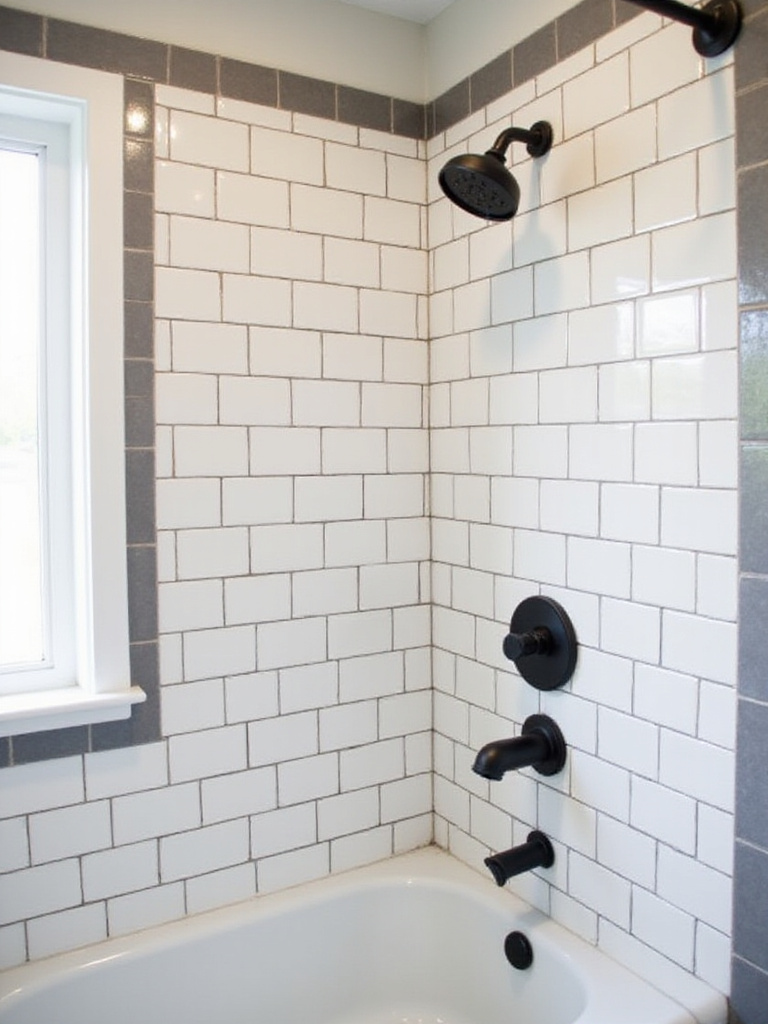
What I tell my readers is to consider the pattern carefully. The standard brick-like running bond is classic. But for a more modern, calm feel, consider a simple stacked grid, where all the grout lines align vertically and horizontally. It’s quieter and feels incredibly disciplined. Extending the tile from floor to ceiling on a single wall, like the one behind the vanity or in the shower, creates a powerful architectural moment without overwhelming the space.
Matte black fixtures are the little black dress of industrial design. They work with almost everything. The non-reflective surface has a quiet, solid presence that polished chrome just can’t match. It absorbs light rather than bouncing it, which helps ground the space and provides a striking contrast against white tile, warm wood, or gray concrete. I’ve seen this play out when a client switched their standard chrome fixtures to matte black—the entire room suddenly felt more curated and sophisticated.
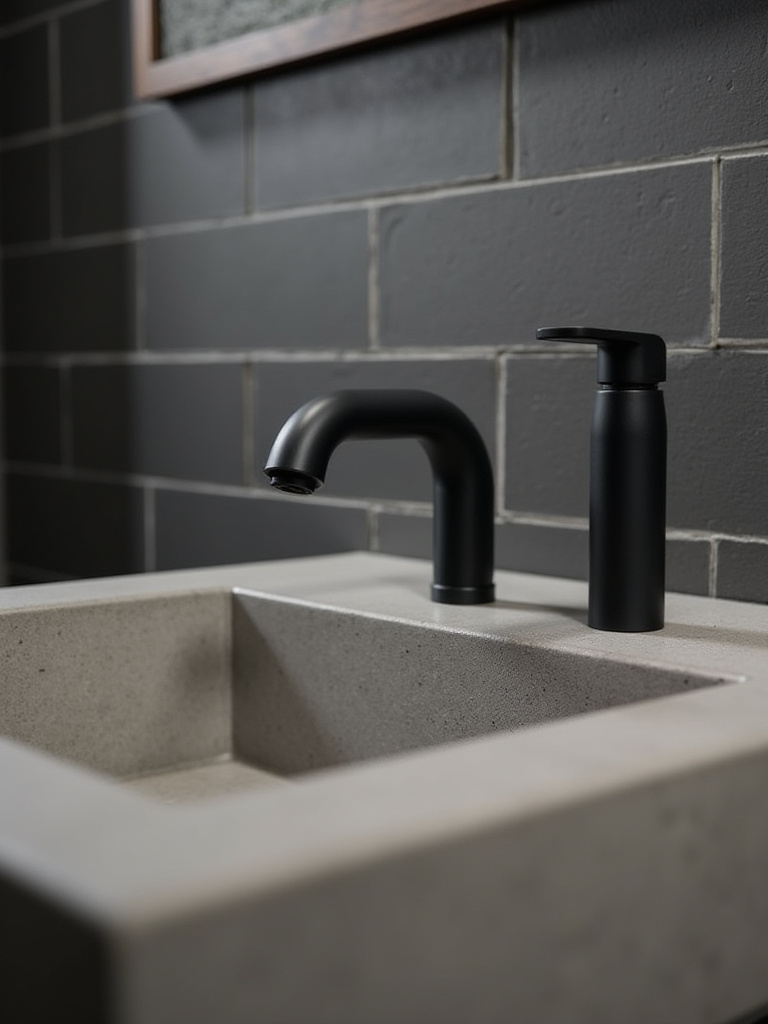
My only caution is to seek quality. There are a lot of cheaply made black fixtures out there where the finish can easily chip or scratch. Look for brands that use a PVD (Physical Vapor Deposition) finish, which is far more durable. And aim for consistency. The faucet, showerhead, towel bar, even the toilet flush lever—when they all share the same matte black finish, it creates a cohesive visual language that ties the whole room together.
A trough sink is a commitment. It’s a strong, sculptural statement drawn from old communal washrooms and workshops. Its elongated form is not only practical—fantastic for a shared bathroom—but it also brings an undeniable, rugged presence. You can have them cast in place or buy them pre-made, but their weight is a serious structural consideration, especially if you want to wall-mount it for that “floating” look.
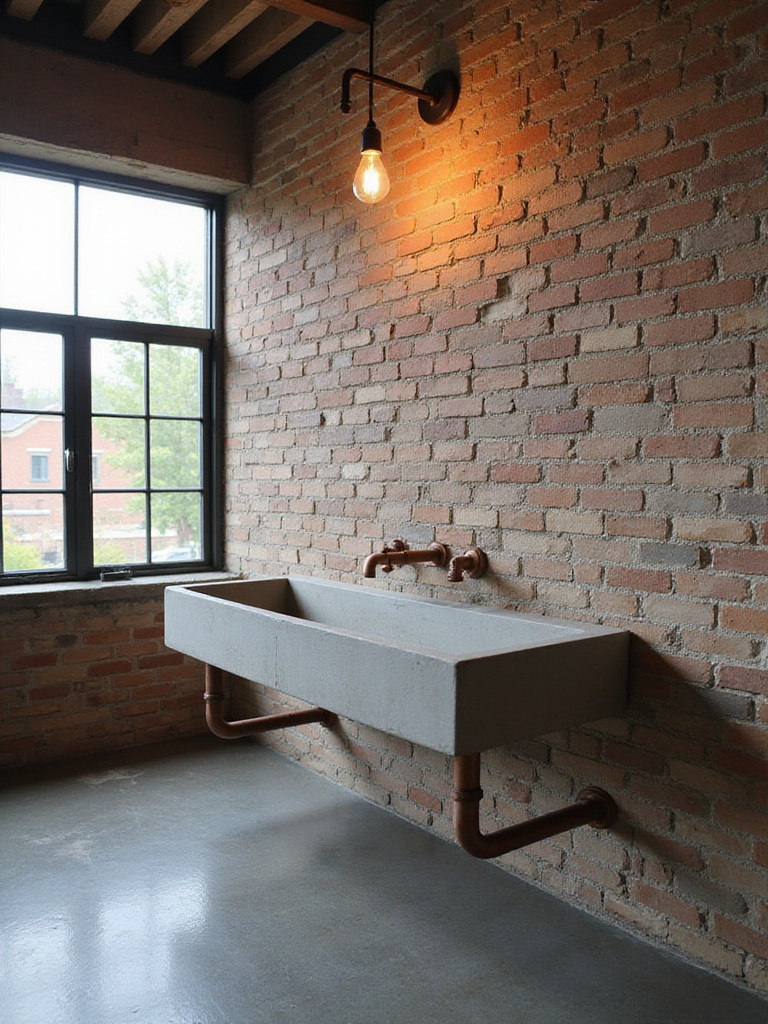
I’ve learned that a piece this dominant needs balance. If you have a massive concrete sink, you need to introduce elements of lightness elsewhere to keep the room from feeling weighed down. Think slim, elegant tapware. A large, frameless mirror. Delicate lighting. This contrast between heavy and light is what creates a dynamic, interesting space. It’s the visual tension that makes a design truly compelling.
This is a subtle but incredibly effective industrial touch. Wire mesh or perforated metal introduces texture and a sense of transparency. Think about using it as an insert in a vanity door—it hints at what’s inside without revealing everything, and it breaks up a solid block of wood or color. I once designed a custom shower screen using laminated glass with a metal mesh embedded inside. It provided privacy while still allowing light to flow through, creating these beautiful, diffused shadows.
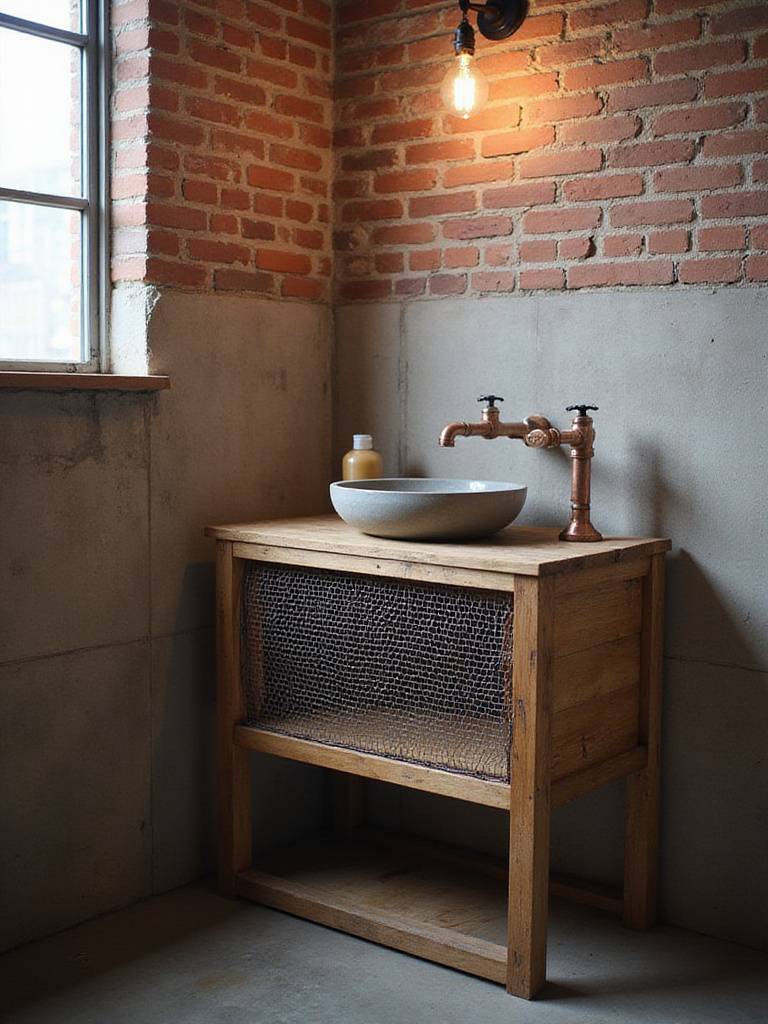
The key is to use these materials in a refined way. From my work in sustainable design, I appreciate that these metal elements are durable and often recyclable, which adds another layer of value. You’re adding an industrial detail that’s light, functional, and can contribute to a feeling of layered depth without adding visual clutter. That’s a minimalist win.
Let’s be honest: the barn door has become a bit of a trend. But at its core, it’s a brilliant, functional solution, especially for tight spaces. My work in urban Nordic apartments has taught me the value of every square centimeter. A traditional swing door eats up valuable floor space. A sliding door eliminates that problem entirely. It’s pure function.
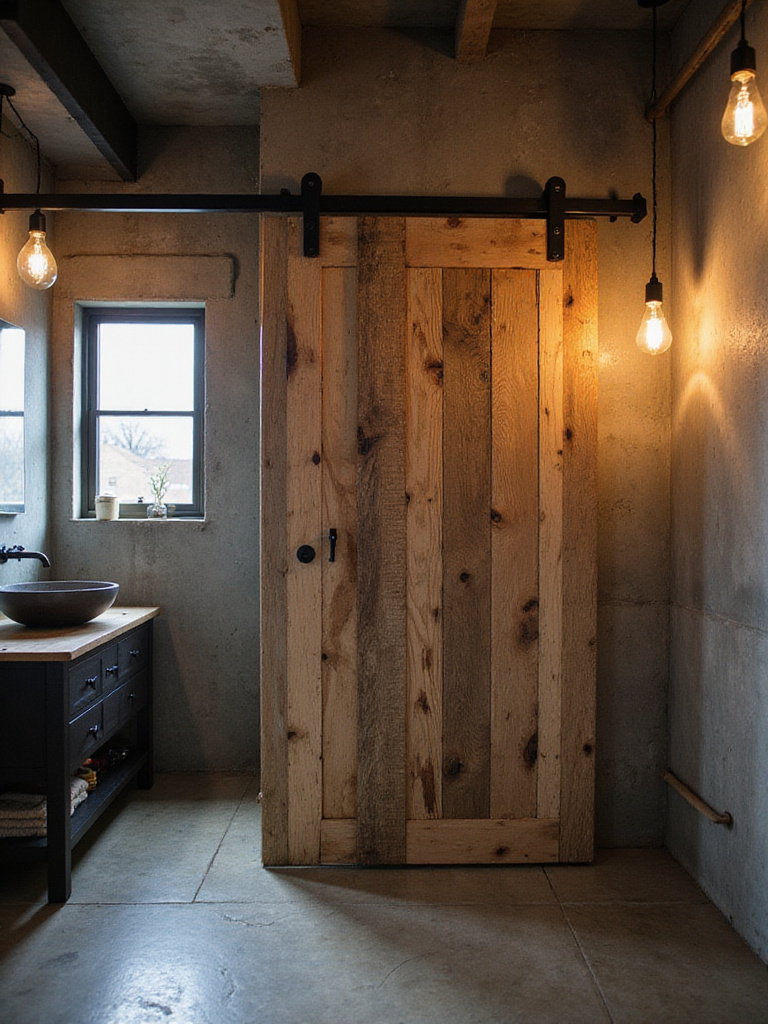
For an industrial bathroom, a door made of reclaimed wood or simple black steel makes a powerful statement. The hardware itself—the track, the rollers—becomes a key part of the design. It’s that honest celebration of mechanics again. The trick is to ensure the scale is right. A massive, heavy door needs to feel balanced by other substantial elements in the room, otherwise it can feel like a random, out-of-place feature.
In Scandinavia, we use mirrors for one primary reason: to amplify light. In a bathroom, a large mirror is essential, and an industrial-style frame can turn this functional necessity into a focal point. Forget delicate, ornate frames. Think simple, strong forms: a thin black metal frame, a raw steel surround with visible rivets, or a grid pattern that mimics old factory windows.

Go as big as your wall can handle. A large mirror not only reflects more light and makes the room feel twice its size, but it also reflects your design choices, doubling the impact of that brick wall or your carefully chosen pendant light. It should feel less like an accessory and more like an architectural element of the room itself.
Open shelving is fantastic. It’s also a challenge. It forces you to be curated and tidy, which is a core part of minimalist living. Pipe-supported shelves are a classic industrial look, and their beauty is in their simplicity and honesty—wood planks held up by plumbing pipes. It’s a system you can customize to fit any nook or wall perfectly.
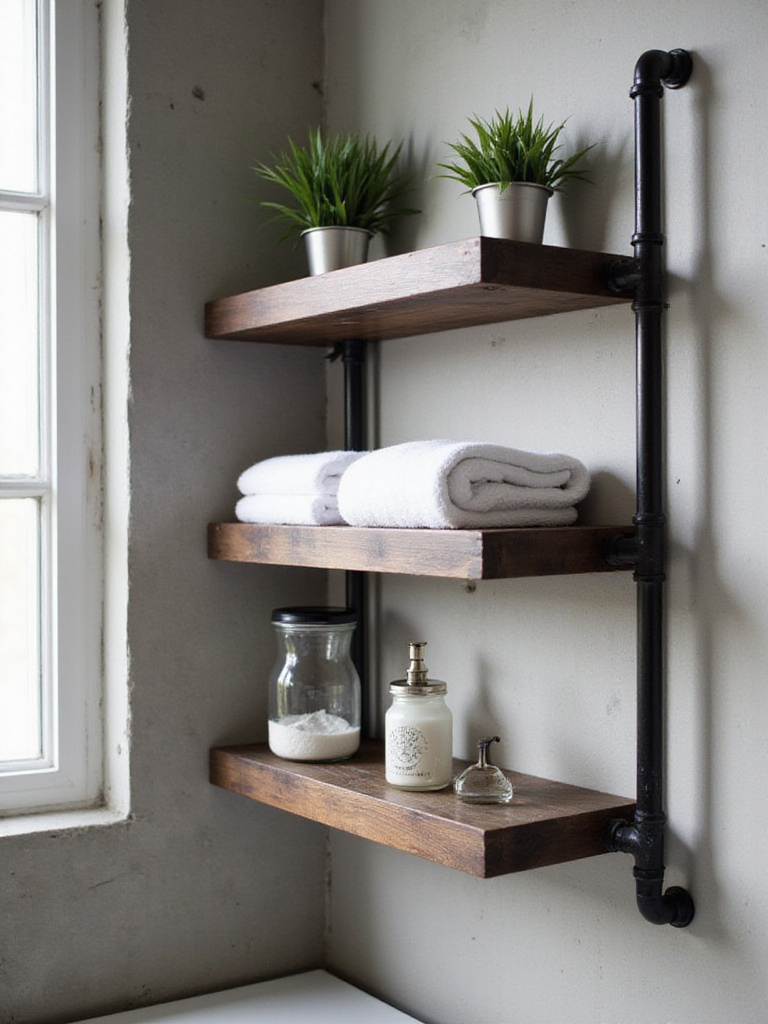
What I tell my clients is this: open shelving is for the things you love to see, not just the things you need to store. It’s for beautifully folded towels, a small plant, a favorite ceramic cup, maybe a bottle of hand soap in lovely packaging. The unsightly stuff—the extra toilet paper, the cleaning supplies—needs to go behind a closed door. Use the negative space on the shelves intentionally. Don’t crowd them. The visual breathing room is just as important as the items themselves.
We touched on this with cage lights, but it’s worth its own point. The Edison bulb is all about atmosphere. Its purpose is not to provide bright, functional light, but to create a mood. That warm, gentle, amber-hued light is the very definition of hygge. It makes you want to slow down, relax, and linger. It flatters both the space and the people in it.
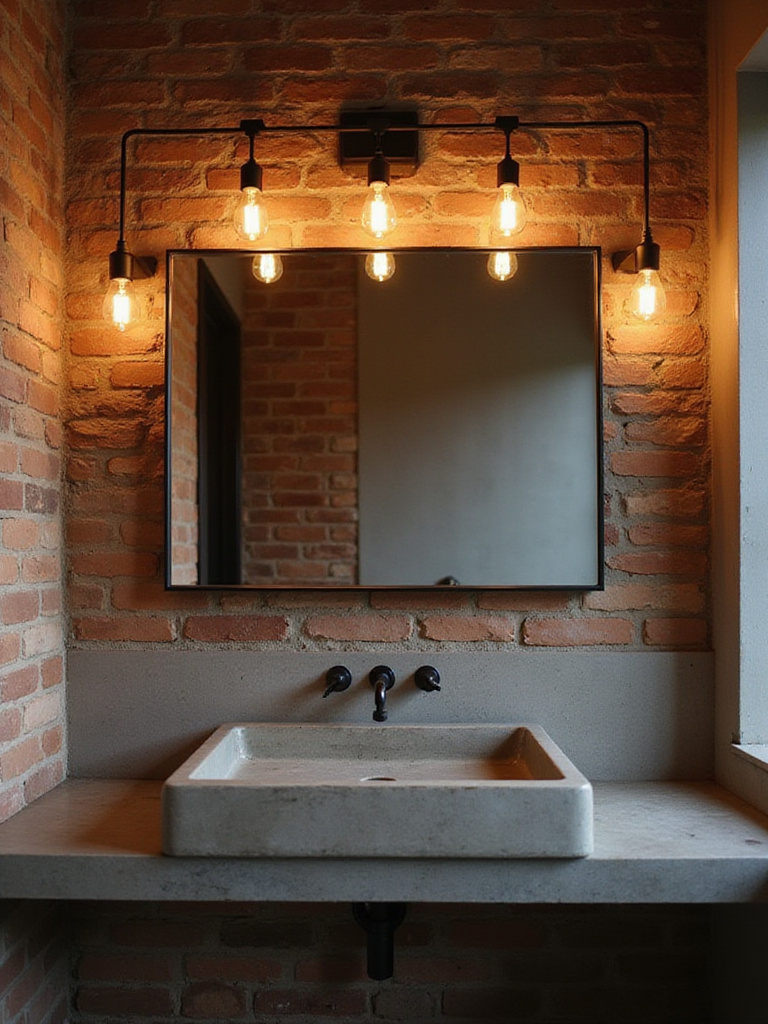
The practical side, however, is that you can’t rely on Edison bulbs alone. They are terrible for tasks that require clear sight, like shaving or applying makeup. This is where layering your lighting becomes critical. Use Edison bulbs in a decorative pendant or sconce for ambient glow, but be sure to pair them with a separate source of clean, direct light around the mirror. This combination of function and feeling is the key to a successful bathroom design.
This is a bold move. A very bold move. And it can be brilliant or it can be a disaster. Bringing a bank of vintage metal lockers into a bathroom provides incredible, compartmentalized storage and a huge dose of authentic industrial character. Each scratch and dent is part of its story.
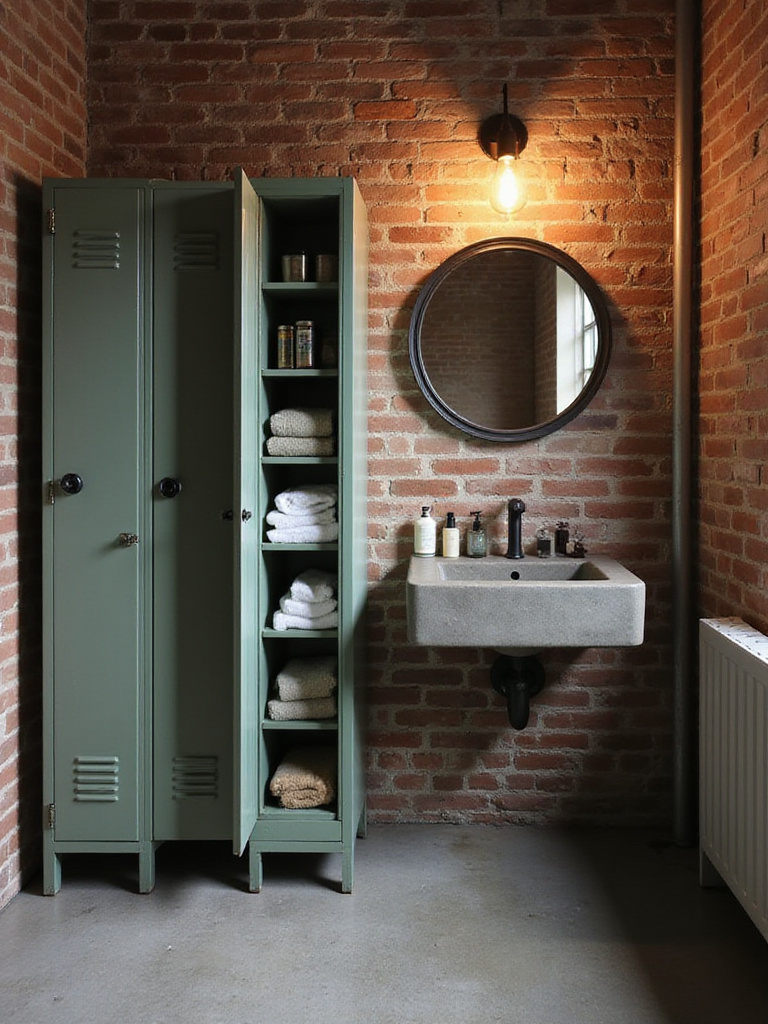
The secret to making this work is balance. You are introducing a very hard, cold, and utilitarian object. To keep the room from feeling like a high school gym, you must counterbalance it with extreme softness. Think of the plushest, most luxurious bath mat you can find. Stacks of thick, soft, white towels. A live plant with soft, cascading leaves. Without that softness, the look falls flat. It’s an expert-level move, but when done right, it’s unforgettable.
As a lover of Scandinavian design, I have a deep appreciation for plywood. Designers like Alvar Aalto showed us its elegance decades ago. Using raw plywood or OSB (Oriented Strand Board) for a vanity or wall paneling is a wonderfully honest choice. You are taking a humble construction material and elevating it to a design feature. The exposed, layered edges of plywood or the compressed flakes of OSB are beautifully textural.
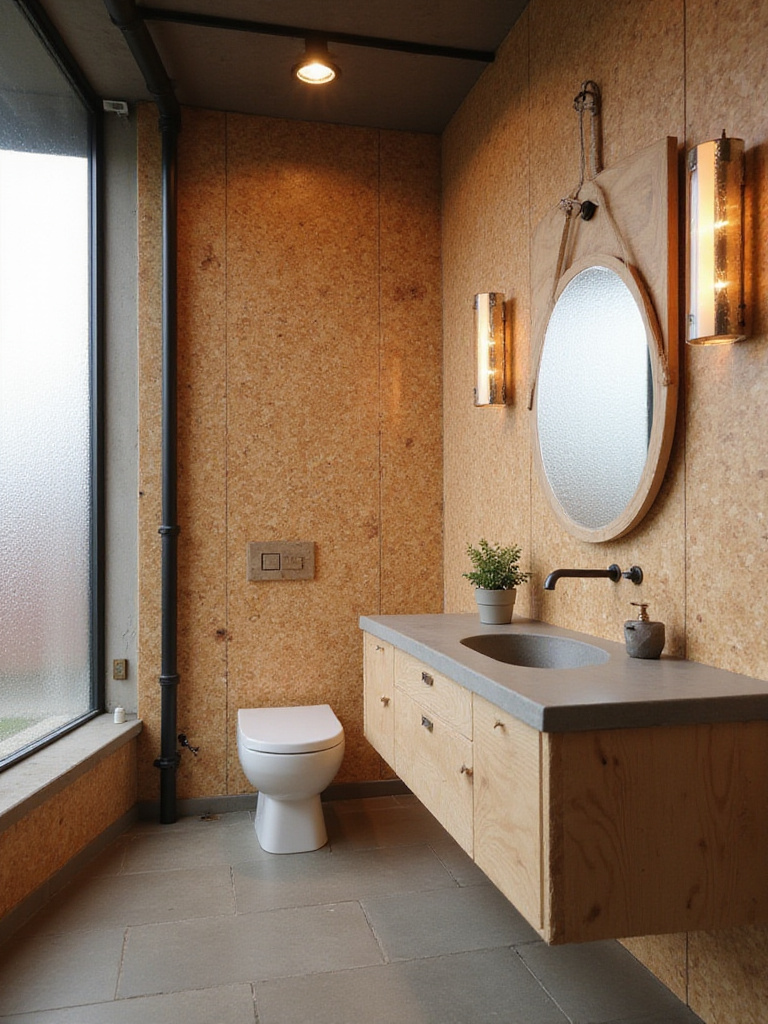
But you have to be practical. I learned the hard way on an early project that not all sealants are created equal. Wood in a bathroom, especially a material like plywood, needs a bomb-proof finish. Use a marine-grade polyurethane and apply multiple thin coats, paying special attention to sealing the edges where water is most likely to penetrate. When protected properly, it brings a modern, architectural warmth that pairs surprisingly well with concrete and metal.
Stone is another of nature’s honest materials. Slate, in particular, has a raw, powerful quality that fits perfectly within an industrial aesthetic. Its natural cleft texture and deep, moody color palette feel ancient and strong. I love using large-format slate tiles on a floor or in a shower. The minimal grout lines create a near-seamless stone surface that feels both rustic and incredibly sophisticated.

Like concrete, stone can feel cold underfoot, so pairing it with radiant heating is a good idea if you live anywhere with a real winter. For a less totalizing touch, consider a slate vessel sink or a simple stone shelf. It introduces that natural, rugged texture without dominating the whole room. Again, proper sealing is essential to prevent staining and water damage in a wet environment.
Art in a bathroom? Absolutely. It’s one of the best ways to inject personality. For an industrial theme, a gallery wall of architectural or technical prints is a perfect fit. Think old blueprints, patent illustrations for simple machines, or stark, black-and-white photos of bridges and factories. The look is graphic, intellectual, and reinforces the theme without being too literal or kitschy.
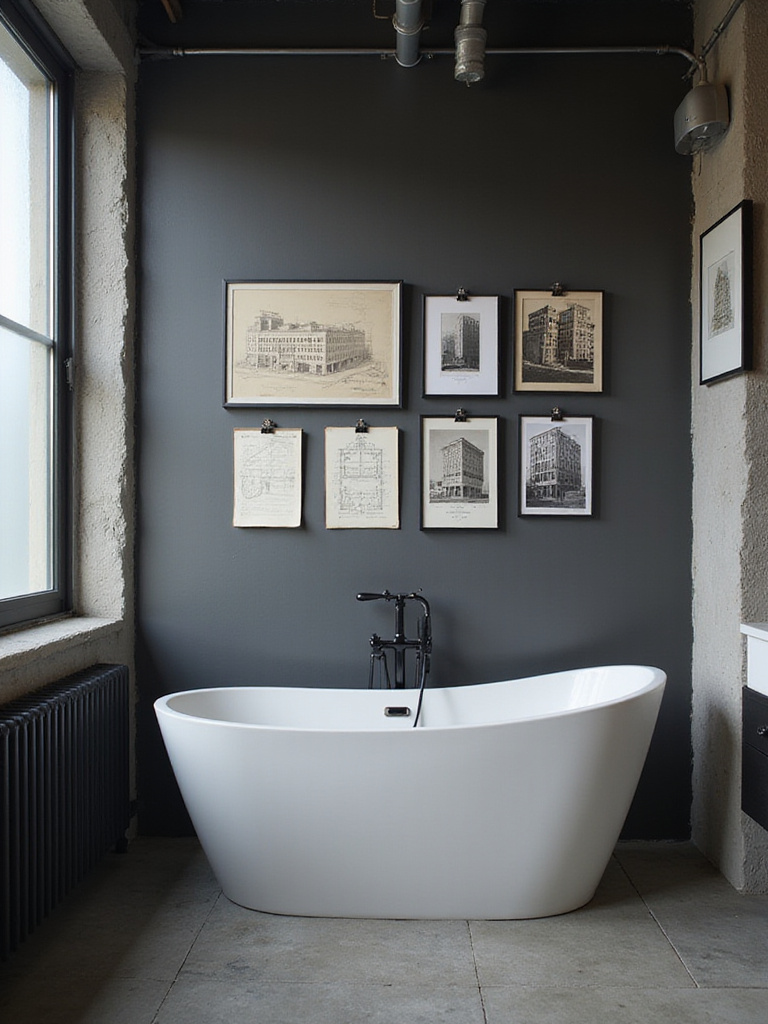
Use simple, identical black metal frames. The uniformity of the frames is what makes a collection of different images feel cohesive. Arrange them in a considered way—perhaps a tight grid or a more organic cluster—on a main wall. It creates a thoughtful focal point and adds a layer of sophistication. It says that this is a space that has been designed with intelligence and care.
A simple pedestal sink is a return to basics. By choosing a model that leaves the plumbing exposed underneath, you are again celebrating the room’s function. The P-trap and the supply lines become part of the design. This is a great solution for smaller bathrooms where a bulky vanity would feel overwhelming. It creates a sense of openness and honesty.
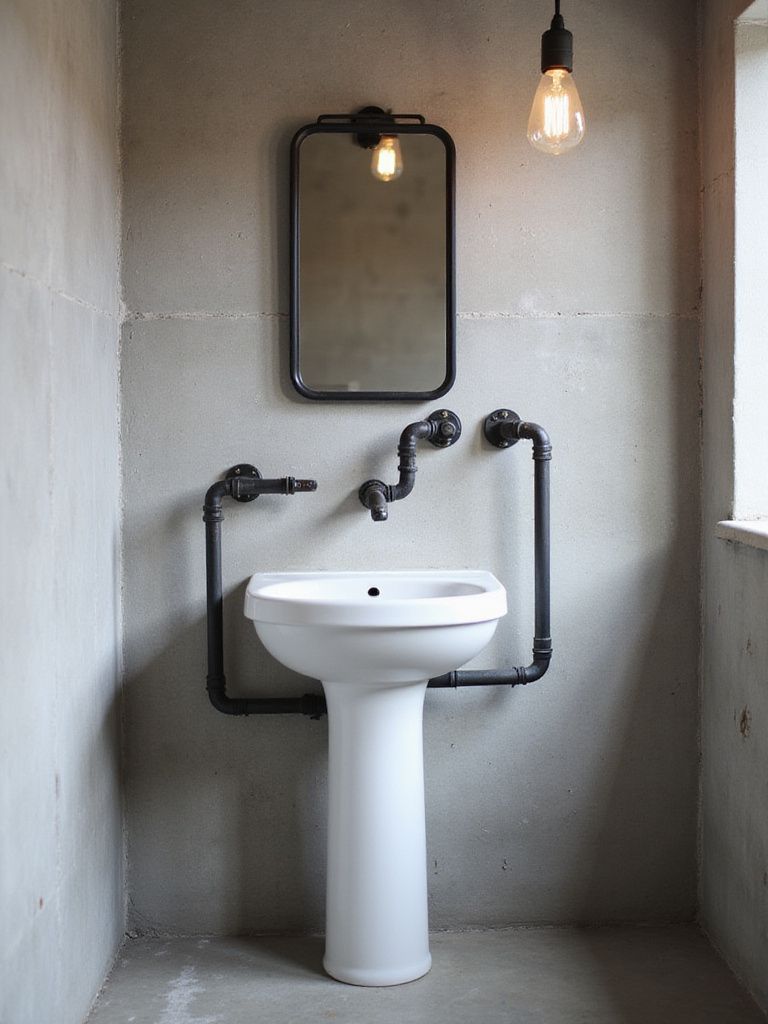
What I often suggest is to invest in beautiful plumbing. Don’t just use the standard chrome pipes. Choose pipes in a finish that matches your faucet and other fixtures—matte black, aged brass, or polished copper. Turning this functional necessity into a deliberate, beautiful detail is what separates a basic bathroom from a truly designed space.
Crittall doors and windows, with their slim black steel frames, are an icon of industrial architecture. Using them for a shower enclosure is a show-stopping move. The black grid pattern creates a stunning graphic statement, framing the shower like a picture and adding a strong architectural element to the room. It defines the space without closing it off, allowing light to flow freely.
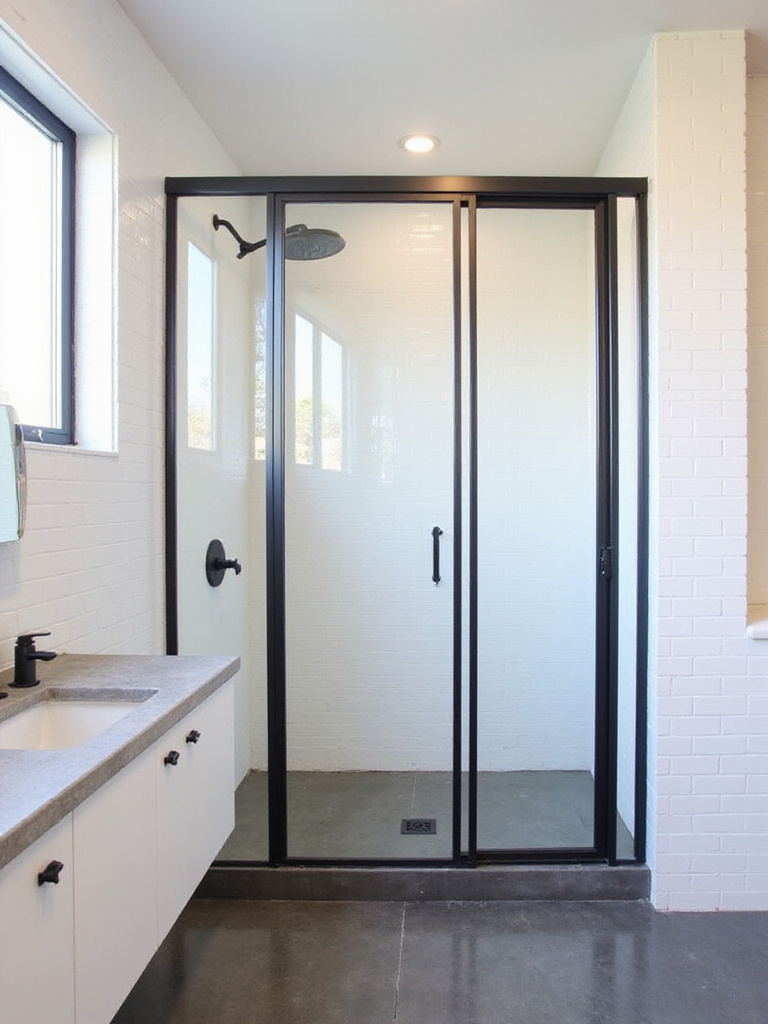
This is not a DIY job. These systems require precise measurement and professional installation to ensure they are perfectly waterproof and operate smoothly. They are an investment, for sure, but they can single-handedly define the style of the entire bathroom. They pair beautifully with simple subway tile, allowing the black grid to be the star of the show.
Let’s say you love the look of concrete but you’re not ready for the commitment of pouring a real concrete wall or floor. This is where modern finishes are incredible. Microcement and other concrete-effect plasters can create a remarkably convincing and completely waterproof surface. They can be applied over existing tile or drywall, making them a fantastic renovation tool.

A skilled plasterer can manipulate the finish to be as smooth or as textured as you like, capturing the subtle variations of real concrete. I’ve used this in many projects to create seamless, grout-free shower walls that are not only beautiful but also incredibly easy to clean. It gives you the raw, monolithic look without the weight and engineering of solid concrete.
A towel warmer is one of those small things that delivers an enormous amount of daily comfort. And in an industrial bathroom, it’s another opportunity to reinforce your aesthetic. Look for models made from black steel pipes that look like a piece of an old radiator, or simple, ladder-style warmers with a raw metal finish.
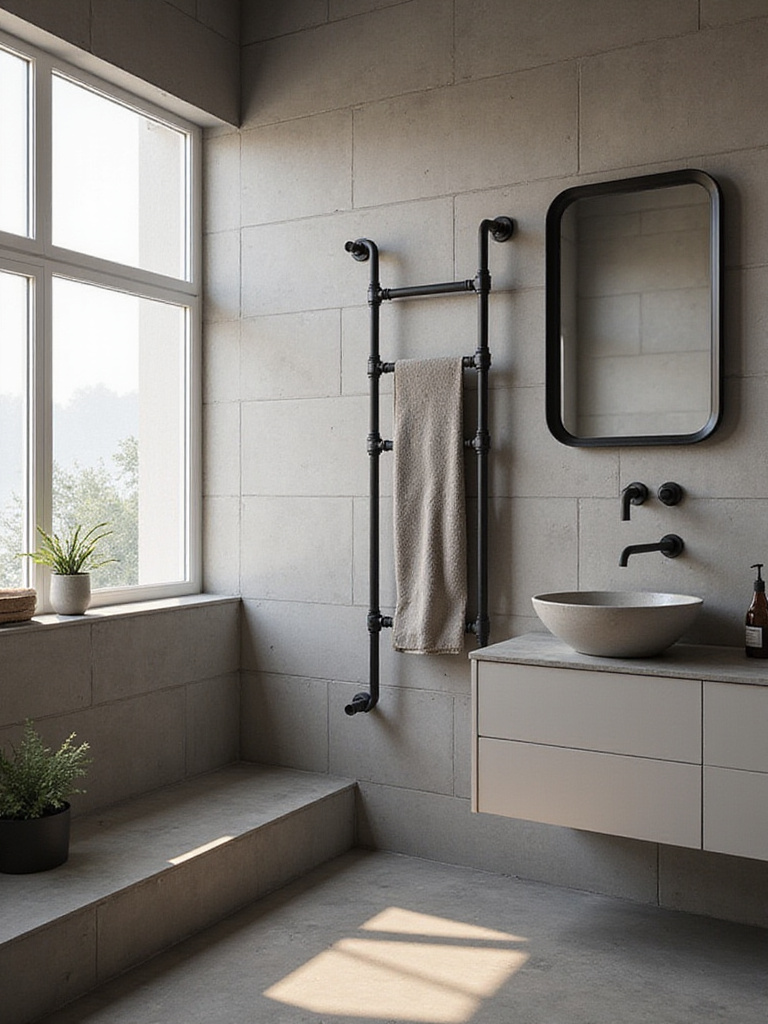
I see this less as a luxury and more as a functional part of creating a hyggelig bathroom. Stepping out of a shower and wrapping yourself in a warm, dry towel on a cold morning is a simple, profound comfort. Functionally, it also helps towels dry quickly, preventing mustiness. It’s a perfect fusion of practical utility and everyday pleasure.
This is the final touch, and it must be done with care. Placing an authentic piece of old machinery—a large gear, a pulley wheel, a heavy-duty valve handle—on a wall as art can be incredibly powerful. It brings a real piece of industrial history into your home. The key word here is authentic.
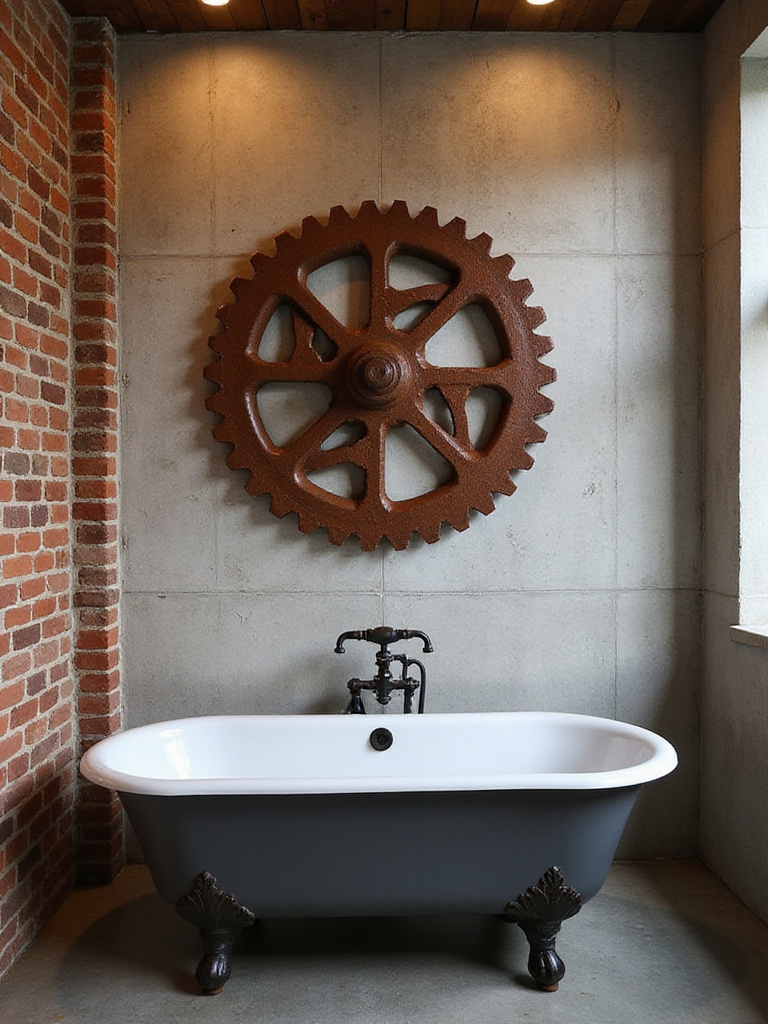
Please, avoid the mass-produced, fake-vintage gears you find at big-box decor stores. They lack soul. The beauty is in the genuine object, sourced from a salvage yard or an antique dealer, with its real patina and wear. A single, large, authentic piece mounted on a clean wall is a thousand times more effective than a dozen small reproductions. It’s a testament to the design principle I value most: quality over quantity, always.
In the end, creating an industrial bathroom that feels good is about editing. It’s about taking these strong, raw, honest elements and thoughtfully pairing them with light, warmth, and softness. It’s where the discipline of the factory meets the comfort of the home. By balancing these two worlds, you can create a space that feels both invigorating and restorative—a place that’s uniquely yours.